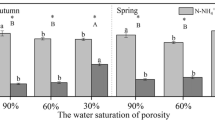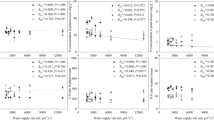Abstract
The Central Asian Taklamakan desert is characterized by a hyperarid climate with less than 50 mm annual precipitation but a permanent shallow groundwater table. The perched groundwater (2–16 m) could present a reliable and constant source of nitrogen throughout the growing season and help overcome temporal nitrogen limitations that are common in arid environments. We investigated the importance of groundwater and nitrogen fixation in the nitrogen metabolism of desert plants by assessing the possible forms and availability of soil N and atmospheric N and the seasonal variation in concentration as well as isotopic composition of plant N. Water availability was experimentally modified in the desert foreland through simulated flooding to estimate the contribution of surface water and temporally increased soil moisture for nutrient uptake and plant–water relations. The natural vegetation of the Taklamakan desert is dominated by plants with high foliar nitrogen concentrations (2–3% DM) and leaf nitrate reductase activity (NRA) (0.2–1 μmol NO −2 g−1 FW h−1). There is little evidence that nitrogen is a limiting resource as all perennial plants exhibited fast rates of growth. The extremely dry soil conditions preclude all but minor contributions of soil N to total plant N so that groundwater is suggested as the dominant source of N with concentrations of 100 μM NO −3 . Flood irrigation had little beneficial effect on nitrogen metabolism and growth, further confirming the dependence on groundwater. Nitrogen fixation was determined by the 15N natural abundance method and was a significant component of the N-requirement of the legume Alhagi, the average contribution of biologically fixed nitrogen in Alhagi was 54.8%. But nitrogen fixing plants had little ecological advantage owing to the more or less constant supply of N available from groundwater. From our data we conclude that the perennial species investigated have adapted to the environmental conditions through development of root systems that access groundwater to satisfy demands for both water and nutrients. This is an ecologically favourable strategy since only groundwater is a predictable and stable resource.





Similar content being viewed by others
References
Amato M, Ladd JN (1988) Assay for microbial biomass based on ninhydrin-reactive nitrogen in extracts of fumigated soil. Soil Biol Biochem 20:107–114
Charley JL, West NE (1977) Micro-patterns of nitrogen mineralization activity in soils of some shrub-dominated semi-desert ecosystems of Utah. Soil Biol Biochem 9:357–365
Day AD, Ludeke KL (1993) Plant nutrients in desert environments. Springer, Berlin Heidelberg New York
Ehleringer JR, Phillips SL, Schuster WSF, Sandquist DR (1991) Differential utilization of summer rains by desert plants. Oecologia 88:430–434
Ehleringer JR, Schwinning S, Gebauer R (1999) Water use in arid land ecosystems. In: Press MC, Scholes JD, Barker MG (eds) Physiological plant ecology. Blackwell, Oxford, pp 347–365
Ellenberg H, Mayer R, Schauermann J (1986) Ökosystemforschung—Ergebnisse des Solling—Projekts 1966–1986. Ulmer, Stuttgart
Erskine PD, Stewart GR, Schmidt S, Turnbull MH, Unkovich M, Pate JS (1996) Water availability—a physiological constraint on nitrate utilisation in plants of Australian semi-arid mulga woodlands. Plant Cell Environ 19:1149–1159
Evans RD (2001) Physiological mechanisms influencing plant nitrogen isotope composition. Trends Plant Sci 6:121–126
Evans RD, Bloom AJ, Sukrapanna SS, Ehleringer JR (1996) Nitrogen isotope composition of Tomato (Lycopersicon esculentum Mill. cv T-5) grown under ammonium or nitrate nutrition. Plant Cell Environ 19:1317–1323
Foetzki A (2003) Water use and water-use efficiency of four perennial plant species in the foreland of a central Asian river oasis. Albrecht von Haller Institute for plant sciences. University of Göttingen, Göttingen
Gebauer RLE, Ehleringer JR (2000) Water and nitrogen uptake patterns following moisture pulses in a cold desert community. Ecology 81:1415–1424
Gutierrez JR, Whitford WG (1987) Chihuahuan desert annuals: importance of water and nitrogen. Ecology 68:409–418
Handley LL, Raven JA (1992) The use of natural abundance of nitrogen isotopes in plant physiology and ecology. Plant Cell Environ 15:965–985
Hansen AP, Pate JS (1987) Evaluation of the 15N natural abundance method and xylem sap analysis for assessing the N2-fixation of understorey legumes in jarrah (Eucalyptus marginata Donn ex Sm.) forest in S.W. Australia. J Exp Bot 38:1446–1458
Högberg P (1986) Nitrogen fixation and nutrient relations in savanna woodland trees (Tanzania). J Appl Ecol 23:675–688
Högberg P, Högberg MN, Quist ME, Ekblad A, Näsholm T (1999) Nitrogen isotope fractionation during nitrogen uptake by ectomycorrhizal and non-ectomycorrhizal Pinus sylvestris. New Phytol 142:569–576
Israel DW (1987) Investigation of the role of phosphorus in symbiotic dinitrogen fixation. Plant Physiol 84:835–840
Jakobsen I (1985) The role of phosphorus in nitrogen fixation in young pea plants (Pisum sativum). Physiol Plant 64:190–196
Kandeler E, Gerber H (1988) Short-term assay of soil urease activity using colorimetric determination of ammonium. Biol Fertil Soils 6:68–72
McKey D (1994) Legumes and nitrogen: the evolutionary ecology of a nitrogen-demanding lifestyle. In: Sprent JI, McKey D (eds) Advances in legume systematics. 5. The nitrogen factor. Royal Botanic Gardens, Kew, pp 211–228
Noy-Meir I (1973) Desert ecosystems, environment and producers. Annu Rev Ecol Syst 4:25–41
Pate JS, Unkovich MJ (1999) Measuring symbiotic nitrogen fixation: case studies of natural and agricultural ecosystems in a Western Australian setting. In: Press MC, Scholes JD, Barker MG (eds) Physiological plant ecology. Blackwell, Oxford, pp 153–173
Pate JS, Stewart GR, Unkovich M (1993) 15N natural abundance of plant and soil components of a Banksia woodland ecosystem in relation to nitrate utilization, life form, mycorrhizal status and N2-fixing abilities of component species. Plant Cell Environ 16:365–373
Pate JS, Unkovich M, Erskine PD, Stewart GR (1998) Australian mulga ecosystems—13C and 15 N natural abundances of biota components and their ecophysiological significance. Plant Cell Environ 21:1231–1242
Robinson D (2001) δ15N as an integrator of the nitrogen cycle. Trends Ecol Evol 16:153–162
Sanginga N, Bowen GD, Danso SKA (1990) Genetic variability in symbiotic nitrogen fixation within and between provenances of two Casuarina species using the 15N-labeling methods. Soil Biol Biochem 22:539–547
Schulze ED, Gebauer G, Ziegler H, Lange OL (1991) Estimates of nitrogen fixation by trees on an aridity gradient in Namibia. Oecologia 88:451–455
Schwinning S, Ehleringer JR (2001) Water use trade-offs and optimal adaptations to pulse-driven arid ecosystems. J Ecol 89:464–480
Shearer G et al (1983) Estimates of N2-fixation from variation in the natural abundance of 15N in Sonoran desert ecosystems. Oecologia 56:365–373
Shearer G, Kohl DH (1986) N2 fixation in field settings: estimates based on natural 15N abundance. Aust J Plant Physiol 13:699–756
Simon L, Stein A, Cote S, Lalonde M (1985) Performance of in vitro propagated A. glutinosa (L.) Gaertn clones inoculated with Frankia. Plant Soil 87:125–133
Sougoufara B, Duhoux E, Dommergues YR (1987) Improvement of nitrogen fixation by Casuarina equisetifolia through clonal selection. Arid Soil Res Rehab 1:129–132
Sprent JI, Geoghegan IE, Whitty PW, James EK (1996) Natural abundance of 15 N and 13C in nodulated legumes and other plants in the cerrado and neighbouring regions in Brazil. Oecologia 105:440–446
Stewart GR, Orebamjo T (1979) Some unusual characteristics of nitrate reduction in Erythria senegalensis DC. New Phytol 83:311–319
Stewart GR, Pate JS, Unkovich M (1993) Characteristics of inorganic nitrogen assimilation of plants in fire-prone Mediterranean-type vegetation. Plant Cell Environ 16:351–363
Thomas FM et al (2000) Ecological basis for a sustainable management of the indigenous vegetation in a central-Asian desert: presentation and first results. J Appl Bot 74:212–219
Thomas FM et al (2001) Temporary increase in plant diversity in a generally species-poor, but highly stable desert ecosystem. Verh Ges Ökol 31:295
Wallace A, Romney EM, Kleinkopf GE, Soufi SM (1978) Uptake of mineral forms of nitrogen by desert plants. In: West NE, Skujins J (eds) Nitrogen in desert ecosystems. Dowden, Hutchinson and Ross, Stroudsburg, pp 130–151
Wanek W, Arndt SK, Huber W, Popp M (2002) Nitrogen nutrition during ontogeny of hemiepiphytic Clusia species. Funct Plant Biol 29:733–740
West NE, Klemmedson JO (1978) Structural distribution of nitrogen in desert ecosystems. In: West NE, Skujins J (eds) Nitrogen in desert ecosystems. Dowden, Hutchinson and Ross, Stoudburg, pp 1–16
Xia X, Li C, Zhou X, Zhang H, Huang P, Pan B (1993) Desertification and control of blown sand disasters in Xinjiang. Science, Beijing
Yoneyama T, Uchiyama T, Sasakawa H, Gamo T, Ladha JK, Watanabe I (1991) Nitrogen accumulation and changes in natural 15N abundance in the tissues of legumes with emphasis on N fixation by stem-nodulating plants in upland and paddy fields. Soil Sci Plant Nutr 37:75–82
Yoneyama T, Muraoka T, Murakami T, Boonkerd N (1993). Natural 15N abundance in tropical plants with emphasis on tree legumes. Plant Soil 153: 295-304.
Acknowledgements
This research was supported by the European Union (Contract ERB IC18-CT98-0275). We wish to thank the many Uigur field workers of Qira Research Station for help during establishment of the field sites, and Helge Bruelheide, Andrea Foetzki, Dirk Gries, Xiangyi Li, Michael Runge, Frank Thomas, Fanjiang Zeng, and Ximing Zhang for help and assistance in the field, and Charles Warren, Wolfgang Wanek and Tina Bell for comments on this manuscript.
Author information
Authors and Affiliations
Corresponding author
Rights and permissions
About this article
Cite this article
Arndt, S.K., Kahmen, A., Arampatsis, C. et al. Nitrogen fixation and metabolism by groundwater-dependent perennial plants in a hyperarid desert. Oecologia 141, 385–394 (2004). https://doi.org/10.1007/s00442-004-1655-7
Received:
Accepted:
Published:
Issue Date:
DOI: https://doi.org/10.1007/s00442-004-1655-7




